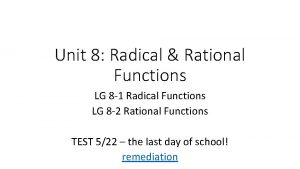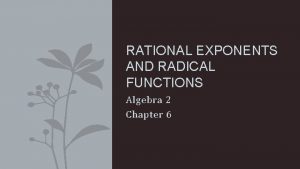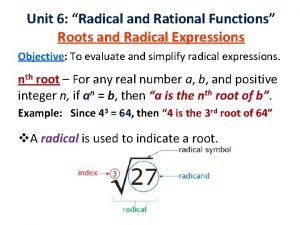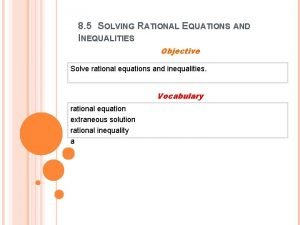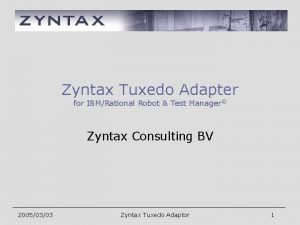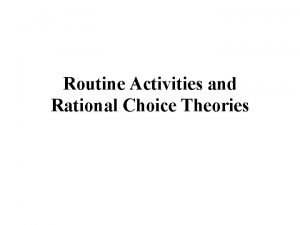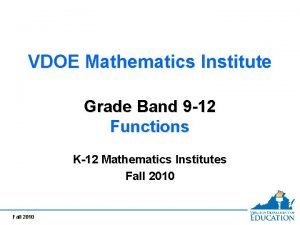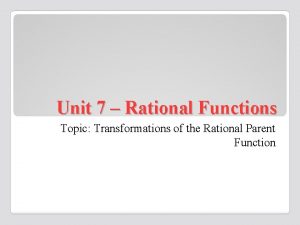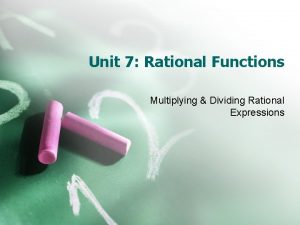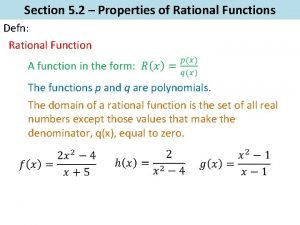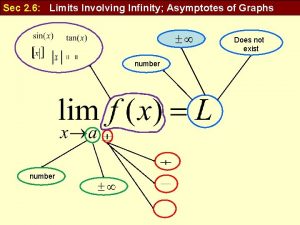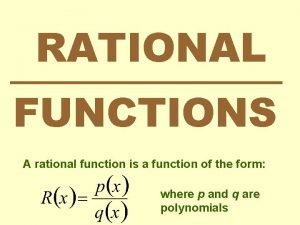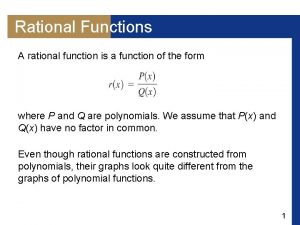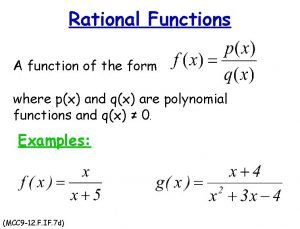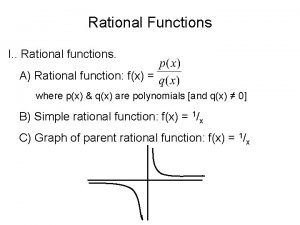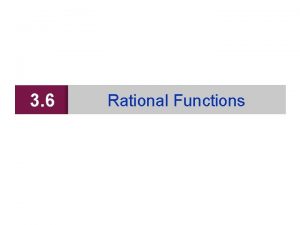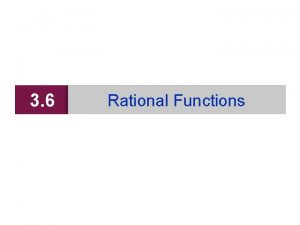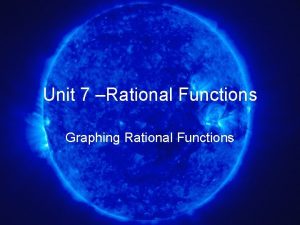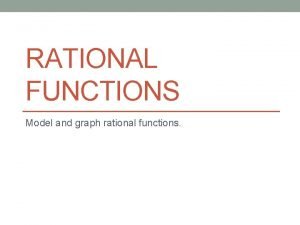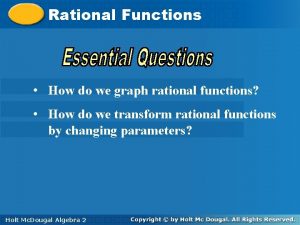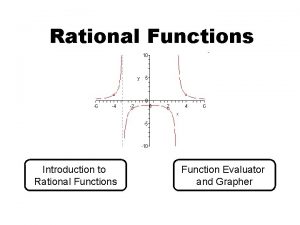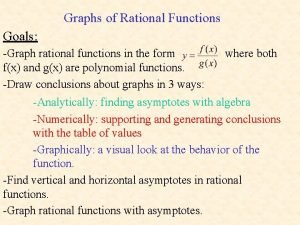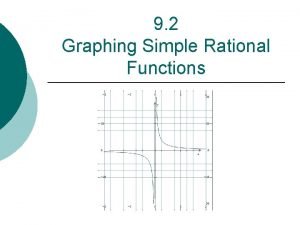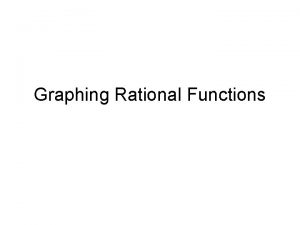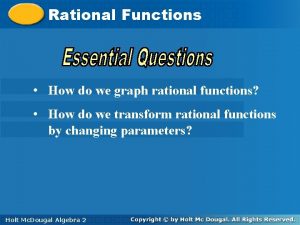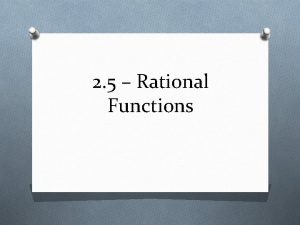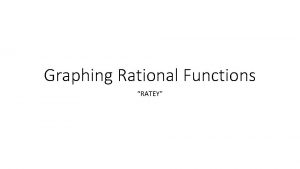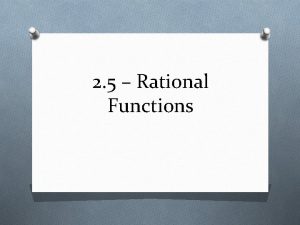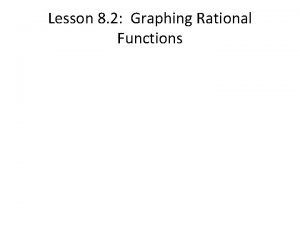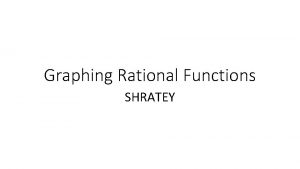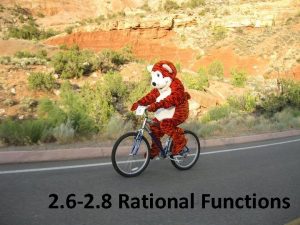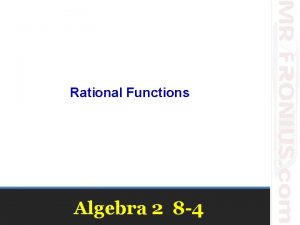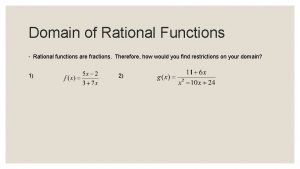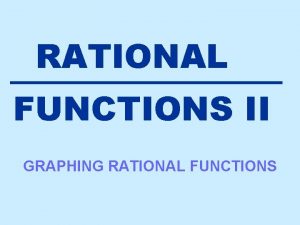Unit 5 Rational Functions ACTIVITY 29 RATIONAL FUNCTIONS
























- Slides: 24

Unit 5 Rational Functions. ACTIVITY 29: RATIONAL FUNCTIONS. Lesson 29. 4 Graphing Rational Functions. Attributes. M³ MECHS – Math - Maldonado TEKS (6)(K) Determine the asymptotic restrictions on the domain of a rational function and represent domain and range using interval notation, inequalities, and set notation. (vi) represent range using inequalities (vii) represent range using set notation.


Warm up Direct and Inverse Variation Given: y varies inversely as x, and Determine whether each data set y = 3 when x = 8. Write and graph represents a direct variation, an the inverse variation function inverse variation, or neither. y varies directly with the square of x. If y = 5 when x = 3, what is the value of y when x = 9? A force varies inversely with the square of the distance from an object. When the distance from the object is 6, the force is 144. Find the force when the distance is 9. Let F be the force and let d be the distance from the object.

recall Attributes of functions: ü ü ü domain and range, x and y intercepts, symmetries, asymptotic behavior, maximum and minimum given an interval.

Prior Knowledge Functions you have studied before this, including i. linear, ii. quadratic, iii. polynomial, iv. absolute value, v. cubic functions, vi. Radical functions are continuous functions

Review Graph key attributes of following functions y = mx + b y = -2 x - 1 f(x) = a (x – h)² + k y = 2(x + 3)² - 1

Esential understanding Transformations of the parent reciprocal function include stretches, compressions (or shrinks), reflections, and horizontal and vertical translations. A rational function may have zero or one horizontal or oblique asymptote and zero or more vertical asymptotes. Quantities x and y are inversely proportional only if increasing x by the factor k means compressing y by the factor.

vocabulary ü A rational function is a function whose rule can be written as a ratio of two polynomials. ü The parent rational function is f (x) = 1/x ü Its graph is a hyperbola, which has two separate branches

vocabulary ü Discontinuous function: is a function whose graph has one or more gaps or breaks. ü Continuous function: is a function whose graph has no gaps or breaks. ü Hole (in a graph): both the numerator and the denominator of a rational function will equal 0 for a particular value of x. As a result, the function will be undefined at this x-value.

Take Notes Key concept Transforming Rational Functions.

Take Notes Key concept Graphs of Rational Functions.

Tutorial - Video Rational Functions https: //www. youtube. com/watch? v=Qxb. Xd. EOz. VP 4

Example 1 Transforming Rational Functions Using the graph of f (x) = 1 x as a guide, describe the transformation and graph each function. g(x) = 1 _ Because h = 3, translate f 3 units right. x-3

Example 2 Transforming Rational Functions Using the graph of f (x) = 1 x as a guide, describe the transformation and graph each function. g(x) = 1 - 2 Because k = -2, translate f 2 units down. x

Example 3 Transforming Rational Functions Using the graph of f (x) = 1 x as a guide, describe the transformation and graph each function. g(x) = 1 _ Because h = -4, translate f 4 units left. x+4

Example 4 Transforming Rational Functions Using the graph of f (x) = 1 x as a guide, describe the transformation and graph each function. g(x) = 1 + 1 Because k = 1, translate f 1 units up. x

Example 5 Graph function. Identify the x- and y-intercepts. State the domain and the range of the function. g(x) = 1 _ x+2 x-int y-int Dom Range

Example 6 Graph function. Identify the x- and y-intercepts. State the domain and the range of the function. g(x) = 1 + 3 x x-int y-int Dom Range

Example 7 Graph function. Identify the x- and y-intercepts. State the domain and the range of the function. g(x) = 1 + 3 x-2 x-int y-int Dom Range

Practice Test 1 •

Practice Test 2 •

Ticket Out The junior class is renting a laser tag facility with a capacity of 325 people. The cost for the facility is $1200. The party must have 13 adult chaperones. How many students n must attend to make the cost C per student no more than $7. 50? A) 140 B) 160 C) 180 D) 200

Closing The Lesson Share in your group the difference between the variations. v. Direct v. Inverse v. Jointly v. Combined

Ticket Out
 Unit 8 rational functions homework 1
Unit 8 rational functions homework 1 Horizontal asymptote rule
Horizontal asymptote rule 6. evaluate
6. evaluate Unit 6 test radical functions
Unit 6 test radical functions Unit 6 radical functions homework 8
Unit 6 radical functions homework 8 Unit 6 review questions
Unit 6 review questions 8-5 solving rational equations and inequalities
8-5 solving rational equations and inequalities Apa itu tuxedo
Apa itu tuxedo Routine activity and rational choice
Routine activity and rational choice Reactant products and leftovers
Reactant products and leftovers Activity corrections
Activity corrections Aon network diagram examples
Aon network diagram examples Activity 1 introductory activity
Activity 1 introductory activity Activity 1 activity 2
Activity 1 activity 2 03 activity 1
03 activity 1 1index
1index Vertical asymptote
Vertical asymptote Rational function parent function
Rational function parent function Parent function of rational function
Parent function of rational function Rational expressions and functions
Rational expressions and functions Rational fraction
Rational fraction Limits involving infinity asymptotes of graphs
Limits involving infinity asymptotes of graphs How to find rational functions
How to find rational functions Vertical
Vertical Rational function
Rational function
